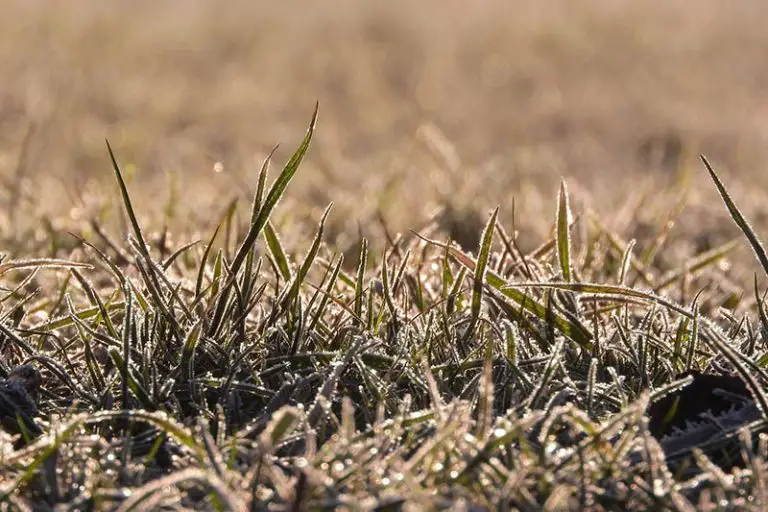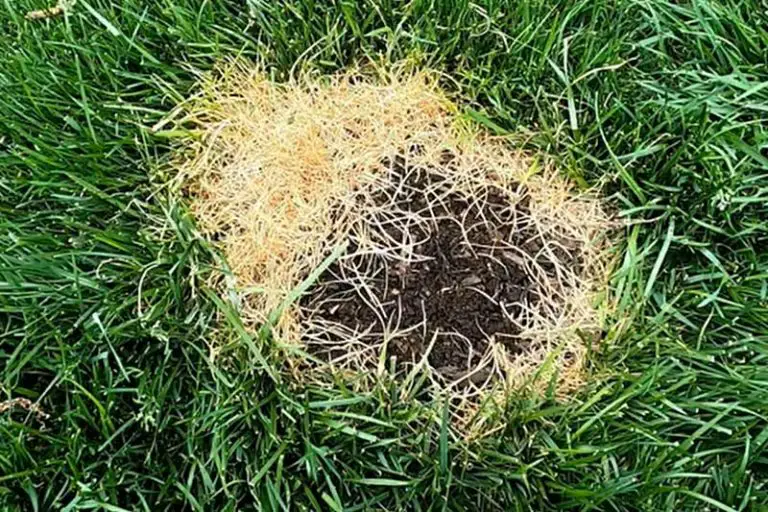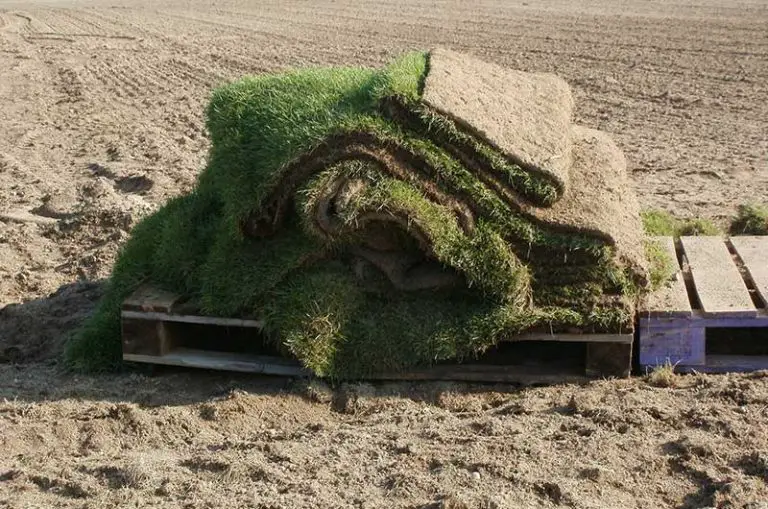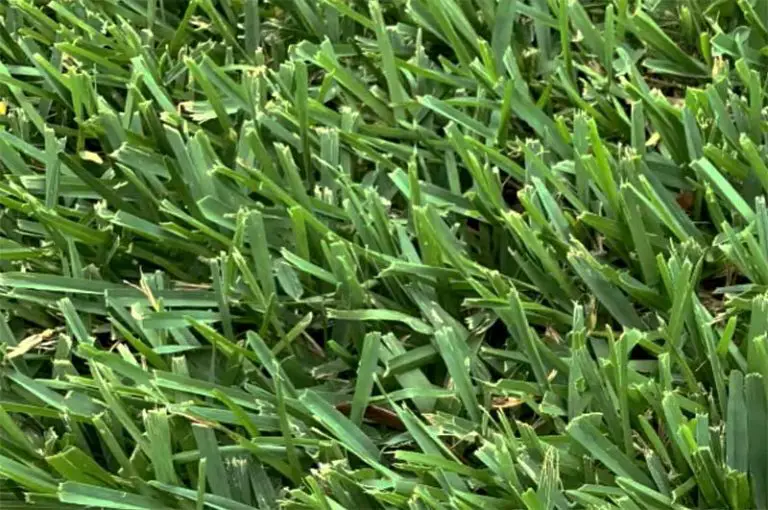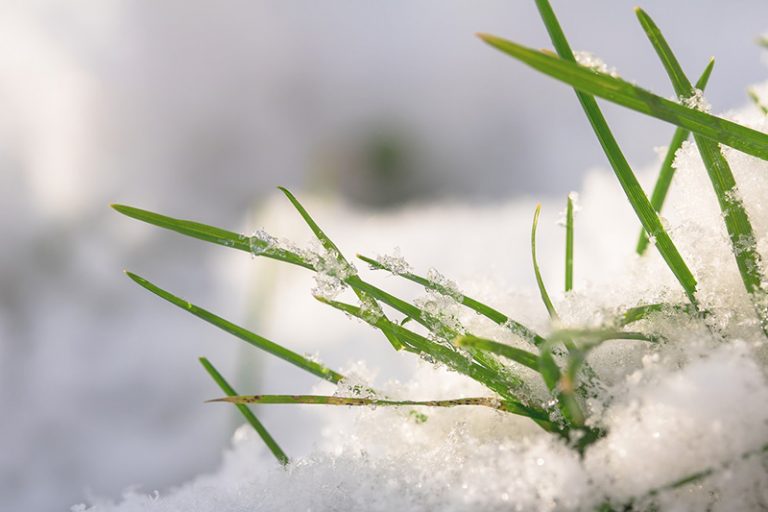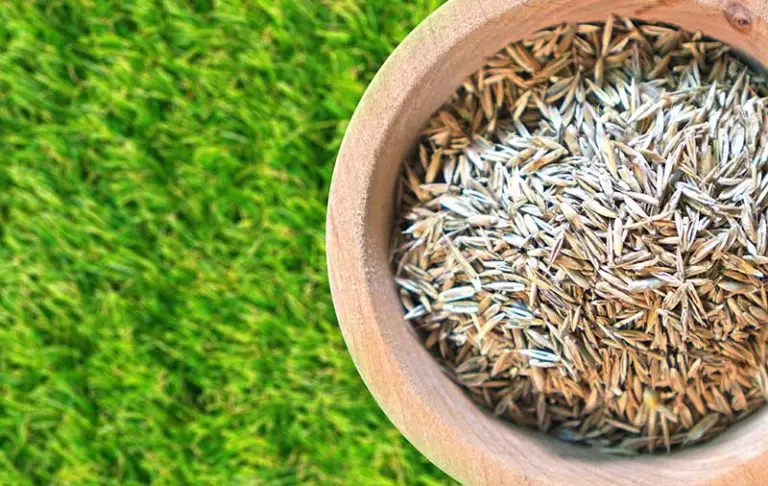Eliminate Powdery Mildew on Your Lawn Easily
Although it isn’t a particularly severe disease, powdery mildew is one of the most unsightly fungal infestations that can take over your lawn. This fungus will make it look like your lawn is dusted with flour or white powder. An infestation of powdery mildew won’t kill your grass plants, but it will weaken them and ruin the overall aesthetics of your lawn.
To get rid of powdery mildew on grass, natural methods of control include using sulfur, vinegar, neem oil, milk, or potassium bicarbonate. These are all natural substances that will kill the white fungus in your grass. Reducing the fungi’s favored conditions will help to prevent future infestations of powdery mildew; this involves reducing shade, improving air circulation, and aerating the turf.
What is the White Powder on Grass in My Lawn?
The white powder on grass in your lawn is most likely the fungal disease powdery mildew. This is particularly true if you have cool-season grass growing in overly moist, shady areas.

What is Powdery Mildew?
Powdery mildew is the common name for the fungus Erysiphe graminis. This fungus is a common lawn disease to cool-season grasses, as it thrives on plants that prefer shady, moist conditions. In addition to grass, powdery mildew can also impact a number of other plants that fit this description.
What Does Powdery Mildew Look Like?
Powdery mildew is a disease that looks like a white cotton-like fungus on lawns; you may notice white spots on the grass or grass with white tips.
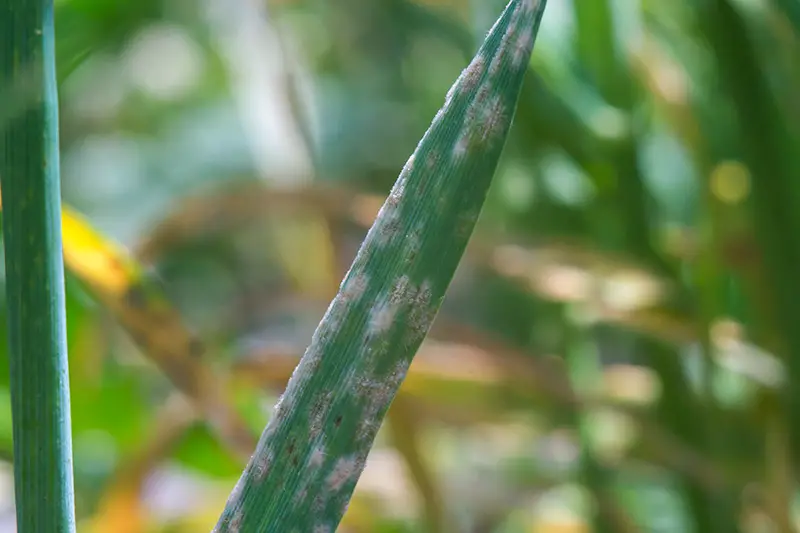
In its initial stages of development, powdery mildew will first appear like a light dusting of white powder on grass. It may appear as though the lawn is dusted with white powder in these initial stages.
As the disease develops, symptoms on the infected areas of the lawn will worsen, looking as though they’re spray-painted with white dust. This dust is actually millions of the spores of the disease-causing fungus. If the infestation is left untreated, it can spread to cover large areas of the turf.
What Causes Powdery Mildew in Grass?
Unlike other fungal lawn diseases, powdery mildew does not require water to develop and spread. It does, however, require high humidity to survive. Because of this, powdery mildew will thrive in grass with poor air circulation, poor drainage, and little access to sunlight. This fungus also requires air temperatures between 60 and 70°F to spread.
When Does Powdery Mildew Develop?
As powdery mildew thrives in cool temperatures and humid conditions, this fungus is most active during the spring and fall. In the summer months, temperatures are too hot for the fungi to survive; similarly, in the winter, the cold temperatures make the spores go dormant.
How Does Powdery Mildew Spread?
Powdery mildew spreads through spores that it produces in the spring. The spores are transported from one place to another in the wind.
Powdery mildew fungi are classified as obligate parasites, which means they need a living host to survive. They overwinter in living grass tissue unlike many other diseases that overwinter in thatch or other dead plant debris.
What Plants are Affected By Powdery Mildew?
In grass, powdery mildew is most commonly found on cool-season grass types. The grasses most susceptible to this fungus are bluegrass varieties, especially Kentucky bluegrass, and different fescue varieties, including tall and fine fescue.
Other plants you may have in your yard affected by powdery mildew include apples, begonias, hollyhocks, lilacs, roses, and some vegetable crops. Powdery mildew can infect any plant; however, the fungal growth is host-specific, meaning it will only spread between plants of the same species. For instance, if you find powdery mildew on roses in your garden, the disease will only spread to other roses.
Will Powdery Mildew on Grass Kill the Turf?
On its own, powdery mildew will not kill grass as it isn’t a particularly serious turfgrass disease. The worst part of this disease in most cases is the appearance of white powder on the grass.
However, in more severe cases, white powdery mildew can cause yellowing and weakening of the grass plants. Weak grass plants are more vulnerable to other more serious conditions; it is these conditions that can then potentially kill the grass.
What Problems Does Powdery Mildew in Grass Cause?
Powdery mildew can create problems with both the appearance and the health of your grass. As we’ve just mentioned, despite the fact that this disease is rarely fatal, powdery mildew can still harm your lawn.
If your lawn suffers repeated or severe infestations of powdery mildew, it can weaken the grass plants over time. The issue with this disease is the coating of white fuzzy mold on the grass that it creates; when this coating covers the blades in a thick layer for a prolonged time, it prevents sunlight from reaching the grass. This consequently interrupts the grass’ process of photosynthesis.
Without access to the sun, your grass plants will be unable to feed themselves. The grass’ inability to feed itself will ultimately stunt the growth of the lawn and cause its green color to fade. And, as we’ve explained, the weakening of the grass plants leaves them more susceptible to stressors like disease; although the powdery mildew won’t kill the grass, it will make the lawn more vulnerable to more serious and fatal conditions.
How to Get Rid of Powdery Mildew on Grass
To get rid of powdery mildew, you can treat the lawn with sulfur, vinegar, neem oil, milk, or potassium bicarbonate. These are all natural ingredients that will work to control powdery mildew and other types of mold on grass. While there are various commercially-available fungicides, chemical solutions are generally ineffective in treating and preventing powdery mildew.
Use Sulfur as a Natural Fungicide
You can use sulfur as a natural substance to get rid of powdery mildew on grass.
Sulfur works as a fungicide as it interferes with the fungi’s cellular respiration. This is also an effective way to eliminate pests like insects, mites, and rodents. On top of these benefits, sulfur is an essential nutrient for plants and will improve the overall health of your grass.
Method: Natural sulfur-based fungicides are commercially available in liquid, dust, or powder form. All you’ll need to do is combine the product with water to create a lawn-safe fungicide for the powdery mildew on your grass.
Get Rid of Powdery Mildew with Vinegar
Vinegar is an effective ingredient in many natural sprays for pest and lawn fungus infestations. You can therefore treat powdery mildew on grass using a DIY vinegar spray.
Natural sprays containing vinegar work to get rid of powdery mildew and other fungal infestations due to their acidic content. Vinegar contains a compound called acetic acid, which is the substance that kills fungal spores without harming the grass plants.
Method:
- Mix 4 tablespoons of vinegar into 2 gallons of water to make a DIY vinegar fungicide. Dilution is essential to ensure your solution won’t harm the grass plants you apply it to; without dilution, the acidic content will be too strong and you may end up burning your lawn.
- Before using the spray, test it out on a small patch to make sure it won’t harm your grass.
- You can then use the spray throughout the entirety of your lawn to get rid of the powdery mildew. Repeated applications of the natural vinegar spray may be necessary to completely eliminate the fungus; however, stop using the spray if you notice signs of burn on the grass.
Get Rid of Powdery Mildew with Neem Oil
Neem oil is another common natural ingredient used to get rid of powdery mildew and other lawn pests and diseases. You can use neem oil as a both control and preventative treatment against these issues.
Derived from the neem tree, neem oil is a substance with natural anti-fungal properties. In addition to powdery mildew, neem oil is an effective treatment for lawn rust and other types of lawn fungus. This organic substance will also work to repel pests from your lawn after application.
Method:
- Combine 5 tablespoons of neem oil with 2 gallons of water.
- Place the mixture into the tank of a suitable sprayer.
- Spray the neem oil solution over the grass, treating the entire lawn or spot treating certain affected areas. Make sure to distribute the neem oil evenly throughout the area.
- Repeat treatments every 1 to 2 weeks to control the development of fungal spores. This will also maintain the efficacy of the neem oil against pests.
Get Rid of Powdery Mildew with Milk
Tests have proven that milk possesses anti-fungal properties and can therefore be used as a natural fungicide ingredient.
Although studies show the anti-fungal properties of milk, experts are still unsure how it actually works to eliminate fungus; it is thought that the proteins in the milk react with sunlight to take on an antiseptic effect.
Method:
- Wait for a day when the weather is forecast to be warm and sunny. This is necessary to activate the anti-fungal properties of the milk proteins.
- Create a milk solution by combining a ½ gallon of milk with 1 ½ gallons of water.
- Place the solution into the tank of a sprayer.
- Apply the treatment to your lawn early in the day.
Get Rid of Powdery Mildew with Potassium Bicarbonate
Another natural ingredient in many DIY lawn sprays is potassium bicarbonate.
Potassium bicarbonate is a mineral that you can purchase in various forms for different lawn care purposes. This substance works to get rid of powdery mildew by killing the fungal spores on contact. In addition to powdery mildew, potassium bicarbonate will also work to control other fungal diseases like leaf spot.
Method:
- To create a DIY potassium bicarbonate spray, mix 2 tablespoons of potassium bicarbonate into 2 gallons of water. Add 1 teaspoon of liquid soap; this will act as a surfactant to help the solution stick to the grass.
- Place the solution into the tank of a sprayer.
- Spray the solution evenly over your lawn to get rid of the powdery mildew.
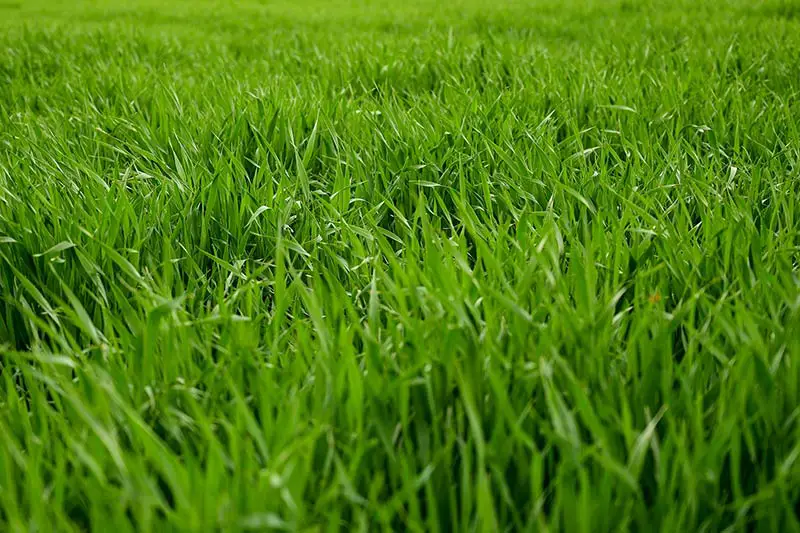
How to Prevent Powdery Mildew on Grass
The best way to prevent powdery mildew on grass is to remove the conditions it requires to survive. To achieve this, you should reduce shady areas in the lawn, improve air circulation, and aerate the lawn as necessary.
Reduce Shade in Lawn
The first step toward preventing powdery mildew is to reduce shade in low-light parts of the lawn. Doing so will reduce the favorable conditions that encourage the development of this lawn disease.
In the areas that don’t receive enough sunlight, the grass never heats up enough to kill the disease-causing fungal spores. This is why powdery mildew thrives in the shadier, low-light parts of the lawn. On top of this, the lack of sunlight in shady areas generates more humidity, further creating the ideal conditions for powdery mildew.
Where possible, reduce the shade in your lawn by removing or reducing whatever is casting the shade. Prune back large trees and other shrubs and plants to allow more sunlight to reach your yard. As an additional tip, consider planting a shade-tolerant grass type in low-light areas; grass that is able to better tolerate shade will be more resistant to issues like powdery mildew.
Improve Air Circulation in Lawn
In addition to shade reduction, improving the air circulation in your lawn will further reduce the conditions under which powdery mildew thrives.
Proper air circulation around all parts of your lawn is essential to minimize humidity. With better air circulation, your lawn will dry out more quickly, limiting the amount of time it remains damp. This will prevent powdery mildew, as well as being an effective method to control moss.
To improve air circulation in your lawn, mow your grass regularly. Find out the best cutting height range for your grass species and maintain the grass at the lower end of this range. This will reduce lawn density, enabling more air to blow through the blades, thus drying them out faster. As we’ve mentioned, reducing foliage on large trees around your lawn will also work to improve air circulation.
Aerate Lawn as Necessary
Not only is it essential for the lawn’s surface, but it’s also crucial to have proper air circulation within the turf. Soil compaction and thatch are two lawn issues that impede this air circulation below the soil level.
Soil compaction occurs naturally over time, whether it arises from foot traffic or weather conditions. Compact soil occurs when the soil particles are pushed tightly together; this pushes out gaps in the soil necessary for the movement of essential elements like water, nutrients, and air in the turf. A lawn with compact soil will drain poorly and have little air circulation, two issues that exacerbate the development of powdery mildew.
You can reduce compaction in your lawn by aerating the soil when necessary. The most effective method of aeration is core aeration; this process involves using a core aerating tool to remove plugs of soil from the turf. The lawn is left with lots of little holes that allow water and air to penetrate deeper into the soil. As a result, the improved circulation will prevent powdery mildew and other diseases from developing on your lawn.

